#norbert lynton
Photo
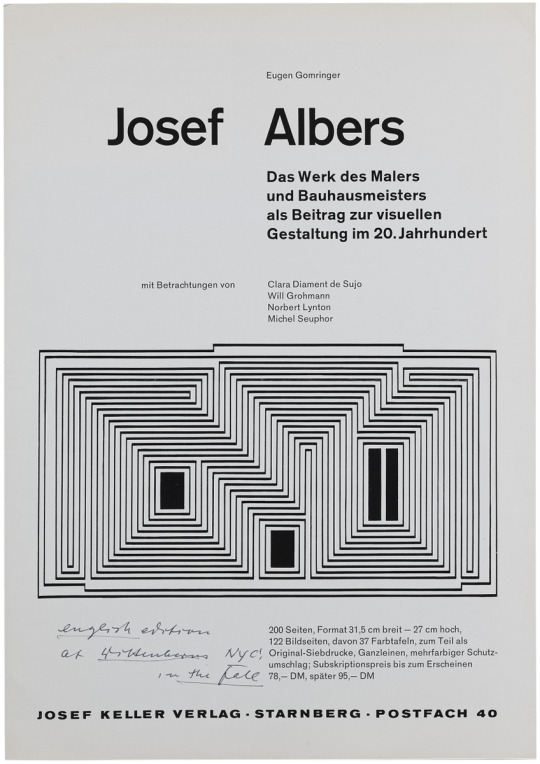
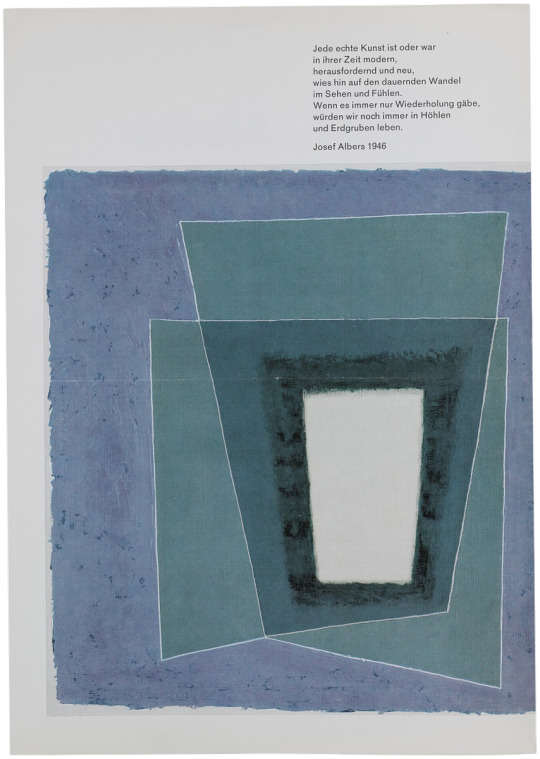

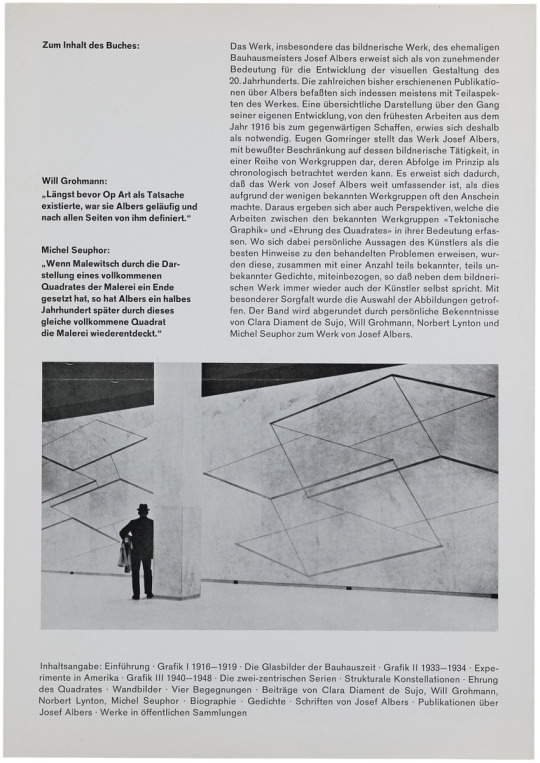
Eugen Gomringer, Josef Albers. Das Werk des Malers und Bauhausmeisters als Beitrag zur Visuellen Gestaltung im 20.Jahrhundert, Essays by Clara Diament de Sujo, Will Grohmann, Norbert Lynton, and Michel Seuphor, Josef Keller Verlag, Starnberg, 1968 [Josef Albers papers, 1929-1970, Box 2, Folder 9: Brochures for Art Work by Josef Albers, circa 1969, Archives of American Art, Smithsonian Institution, Washington, D.C.]
#graphic design#art#drawing#geometry#pattern#structure#catalogue#catalog#cover#josef albers#eugen gomringer#clara diament de sujo#will grohmann#norbert lynton#michel seuphor#josef keller verlag#josef albers papers#archives of american art#smithsonian institution#1960s
118 notes
·
View notes
Text
G’eth Character Name Bank
First Names
Masculine Names
Alfred, Andrew, Arlo, Arthur, Balthazar, Barry, Ben, Benedick, Bernard, Burchard, Cedric, Charibert, Crispin, Cyrill, Daegal, Derek, Digory, Drustan, Duncan, Edmund, Edwin, Elric, Evaine, Frederick, Geffery, George, Godfreed, Gregory, Guy, Harris, Harry, Horsa, Hugh, Humphrey, Iago, Jack, Jeremy, John, Kazamir, Kenric, Lawrence, Leoric, Lorik, Luke, Lynton, Lysander, Madoc, Magnus, Maukolum, Micheal, Miles, Milhouse, Mordred, Mosseus, Ori, Orvyn, Neville, Norbert, Nycolas, Paul, Percival, Randulf, Richard, Robert, Roderick, Stephen, Tennys, Theodoric, Thomas, Tristan, Tybalt, Victor, Vincent, Vortimer, Willcock, Willian, Wymond
Feminine Names
Adelin, Alice, Amelia, Beatrix, Beryl, Bogdana, Branwyne, Brigida, Catalina, Catherine, Claudia, Crystina, Deanna, Desdemona, Elaine, Elinora, Eliza, Enide, Eva, Ferelith, Fiora, Freya, Gertrude, Gregoria, Gueanor, Gwen, Gwendolyn, Hannah, Hegelina, Helen, Helga, Heloise, Henrietta, Igraine, Imogen, Jacquelyn, Jane, Jean, Jenny, Jill, Juliana, Juliet, Katie, Leela, Lettice, Lilibet, Lilith, Lucy, Luthera, Luz, Lyra, Malyna, Margherita, Marion, Meryl, Millie, Miranda, Molle, Morgana, Morgause, Nezetta, Nina, Novella, Olwen, Oriana, Oriolda, Osanna, Pamela, Petra, Philippa, Revna, Rohez, Rosalind, Rose, Sallie, Sarra, Serphina, Sif, Simona, Sophie, Thomasine, Tiffany, Ursula, Viola, Winifred, Yrsa, Ysabella, Yvaine, Zelda, Zillah
Gender-Neutral/Unisex Names
Adrian, Alex, Aiden, Arden, Ariel, Auden, Avery, Bailey, Blaire, Blake, Brett, Breslin, Caelan, Cadain, Cameron, Charlie, Dagon, Dana, Darby, Darra, Devon, Drew, Dylan, Evan, Felize, Fenix, Fernley, Finley, Glenn, Gavyn, Haskell, Hayden, Hunter, Jace, Jaime, Jesse, Jo, Kai, Kane, Karter, Kieran, Kylin, Landon, Leslie, Mallory, Marin, Meritt, Morgan, Nell, Noel, Oakley, Otzar, Paris, Peregrine, Quant, Quyn, Reagan, Remy, Robin, Rowan, Ryan, Sam, Samar, Sasha, Sloan, Stace, Tatum, Teegan, Terrin, Urbain, Vahn, Valo, Vick, Wallace, Waverly, Whitney, Yardley, Yarden, Zasha
Surnames
Surnames, Patrilineal - First Name (Patrilineal Surname)
Ace, Allaire, Appel, Arrow, Baker, Bamford, Barnard, Beckett, Berryann, Blakewood, Blanning, Bigge, Binns, Bisby, Brewer, Brickenden, Brooker, Browne, Buller, Carey, Carpenter, Carter, Cheeseman, Clarke, Cooper, Ead, Elwood, Emory, Farmer, Fish, Fisher, Fitzroy, Fletcher, Foreman, Foster, Fuller, Galahad, Gerard, Graves, Grover, Harlow, Hawkins, Hayward, Hill, Holley, Holt, Hunter, Jester, Kerr, Kirk, Leigh, MacGuffin, Maddock, Mason, Maynard, Mercer, Miller, Nash, Paige, Payne, Pernelle, Raleigh, Ryder, Scroggs, Seller, Shepard, Shore, Slater, Smith, Tanner, Taylor, Thatcher, Thorn, Tilly, Turner, Underwood, Vaughan, Walter, Webb, Wilde, Wood, Wren, Wyatt, Wynne
Surnames, Townships in G’eth - First Name of (Location)
Abelforth, Argent Keep, Barrow Springs, Barrowmere, Bedford, Brunhelm, Bumble, Casterfalls, Dunbridge, Falmore Forest, Folk’s Bounty, Frostmaid, Fulstad, Heller’s Crossing, Hertfordshire, Humberdale, Inkwater, Little Avery, Marrowton, Mistfall, Mistmire, Morcow, Necropolis-on-Sea, Otherway, Parsendale, Piddlehinton, Port Fairwind, Redcastle, Ransom, Rutherglen, Saint Crois, Tanner’s Folly, Tavern’s Point, Wilmington
Surnames, Geographical Locations in G’eth - First Name of the (Location)
Cove of Calamity, Deep Woods of Falmore, Eastern Isles, Eastern Mountains, Foothills, Frozen Peak, Lakes, Maegor Cobblestones, Northern Mountains, Southern Isle, Tangle, West Coast, Wild Wild Woods, Woods of Angarad
Surnames, Nickname - First Name the (Something)
Bald, Bastard, Bear, Bearded, Big, Bird, Bold, Brave, Broken, Butcher, Bruiser, Careless, Caring, Charitable, Clever, Clumsy, Cold, Confessor, Coward, Crow, Cyclops, Devious, Devoted, Dog, Dragonheart, Dreamer, Elder, Faithful, Fearless, Fey, Fool, Friend, Generous, Giant, Goldheart, Goldfang, Gouty, Gracious, Great, Hag, Handsome, Hawk, Honest, Huge, Humble, Hungry, Hunter, Innocent, Ironfist, Ironside, Keeper, Kind, Lesser, Liar, Lionheart, Little, Loyal, Magical, Mercenary, Merchant, Messenger, Old, Orphan, Pale, Polite, Poet, Poor, Prodigy, Prophet, Proud, Reliable, Romantic, Rude, Selfish, Sellsword, Scab, Scholar, Shield, Shy, Singer, Sirrah, Slayer, Slug, Small, Stoneheart, Swift, Tadde, Talented, Tart, Tenacious, Timid, Tiny, Tough, Traveller, Trusted, Truthful, Viper, Wizard, Wolf, Wyrm
105 notes
·
View notes
Photo

Willem de Kooning (24 Nisan, 1904 – 19 Mart, 1997)
“Sanatçı 1947’de New York sanat dünyasını soyut bir görünümüne sahip olan ve kışkırtıcı anlamlar taşıyan siyah ve beyaz resimlerden oluşan sergisiyle etki altına aldı. Fırça vuruşlarındaki özgürlük ve kesinlik, seyredenleri çarparcasına etkilemekteydi. Birkaç yıl sonra 1953’de de Kooning, anıtsal kadın konusunu işleyen sevme ve reddetme imgelerinin çarpıştığı bir dizi büyük resimlerden oluşan sergisiyle hayranlarını şaşırttı. Bunlar Avignon’lu Kızlar gibisinden çocuk resimleriydi; ancak aralarında devrim çocukları olanlar da vardı. Söz konusu yapıtlar, sanatçının önceki resimlerinde kavranan bir gerçeği açıkça vurgulamaktadır: 1948-9’ların soyut siyah, beyaz resimleri, insan anatomisine de dayanmaktaydı. Yeni yaptığı resimler de Kooning’in fırça kullanmaktaki ustalığını sergilemekteydi. Yanlış değerlendirilmiş bile olsa sanatçıyı Yeni Amerikan Resmi’nin öncüsü olarak kabul ettiren, bu özelliklerine duyulan hayranlıktı.
Willem’de Kooning’in resimleri ve son günlerde yaptığı heykelleri en başta, bir gelişim süreci sonunda ortaya çıkan yapıtlardır. İster bilinçle, ister bilinçsiz yapılmış olsunlar, tuvallerde biçimleri akla getiren işaretler, boşluk zemini veren biçimlerle karşılaşır; biçimlerin boşluklarını hatta renklerin belli bir figür, bir suret oluşturduklarını fark ederiz.”
Modern Sanatın Öyküsü - Norbert Lynton
Remzi Kitabevi
3 notes
·
View notes
Text

Grey Relief on Black, 1959
These are just a few information about Tàpies's life, career, and art works. If you are interested and would like more information about Antoni Tàpies I would encourage to check out these articles and resources below:
Solervicens, Julia. "Retracing The Art Of Antoni Tàpies, From Surrealism To Pop Art." Culture Trip. The Culture Trip, 12 Jan. 2016. Web. 12 June 2021.
Cembalest, Robin. "'The Last of a Kind'." ARTnews.com. ARTnews.com, 18 Nov. 2019. Web. 12 June 2021.
Masters, Christopher. "Antoni Tàpies Obituary." The Guardian. Guardian News and Media, 07 Feb. 2012. Web. 12 June 2021.
Grimes, William. "Antoni Tàpies, Spanish Abstract Painter, Dies at 88." The New York Times. The New York Times, 07 Feb. 2012. Web. 12 June 2021.
Clelia. "Antoni Tàpies: Biography, Works and Exhibitions." Alejandra De Argos. 18 Aug. 2016. Web. 12 June 2021.
Tate. "'Grey and Green Painting', Antoni Tapies, 1957." Tate. 01 Jan. 1970. Web.
Tàpies, Antoni. "Rinzen." MACBA Museum of Contemporary Art of Barcelona. 2021. Web. 30 June 2021.
Barcio, Phillip. "On a Journey with Antoni Tàpies: Ideelart." IdeelArt.com. 3 May 2019. Web. 04 July 2021.
Lynton, Norbert. "Antoni Tàpies - Praemium Imperiale." 高松宮殿下記念世界文化賞. Web. 04 July 2021.
10 notes
·
View notes
Text
How far German Expressionism was developed by directors and how far by other influences
2017
Norbert Lynton said that “all human action is expressive… all art is expressive of its author and of the situation in which he works”. Therefore, the link between directors and their surroundings is undeniable; whilst a film may technically speaking be the creation of it director, it is also a creation of the many other outside influences which would have affected a director and his choices when making the film. The Cabinet of Dr Caligari (Weiner, 1920) and Nosferatu (Murnau, 1922) were both products of the German Expressionist era which lasted from 1920 until 1927 and was a result of an isolated Weimar Germany, whose people were left shaken and horrified by the aftermath of WWI. A cinema import ban meant that the demand for films was not met by imports from only Denmark and Sweden and so UFA, as a result of inflation driven cinema as well as public demand, produced 500-600 films annually. This made it the largest European film production studio until WWII, with its films clearly showing the effects that post-WWI Germany was having on its people.
Widely regarded as the first true German Expressionism film, Weiner’s The Cabinet of Dr Caligari was hugely instrumental in establishing key aesthetics and themes of the style, namely the use of highly stylised visuals. The Cabinet of Dr Caligari shows this through its use of painted shadows and chiaroscuro. The painted shadows add to the sense of abstract expressionism created by the set, which was designed by Hermann Warm, Walter Reimann, and Walter Röhrig, creating a world which was not realist but rather representational. The horrors of Weimar Germany would have been all too common to the viewers at the time, indeed in his essay Where The Horror Came From David Hudson noted that 700000 Germans starved to death between Armistice Day and the signing of the Treaty of Versailles and thus for Germany horror was both a reality and a fascination. As classified by Young and Rubican, certain audience members could have been ‘strugglers’, meaning that they watched films as a means of escape from their everyday life, whereas some may have been ‘reformers’, indicating that they are intellectual and socially aware; by adopting the expressionist style The Cabinet of Dr Caligari and films like it would have offered a take on the events of the day that were not realist, and therefore allowed some form of escapism, but also addressed the issues of the day that were highly relevant to audiences upon the film’s release.
An example of this in The Cabinet of Dr Caligari could be that one interpretation of the films painted shadows could be that they represent control. Shadows are supposed to be natural, fluid results of an object blocking light. When shadows are cast by living objects in the way of the sun it is within their nature to move and so by having them painted and static the common German Expressionist themes of a distrust of authority and extreme paranoia were reflected as it could indicate an unnatural control by a larger power. However, a more literal reason for the painted shadows was that due to the economic crisis that Germany found itself in after the war, electric lighting could not be relied on and so by physically painting the shadows onto the set the need for extra lighting was lost. Either way, whether the shadows are interpreted as a symbolic representation of the unimaginable, fear-driven reality of Weimar Germany, or just as a response to the need to reduce costs brought in by electric lighting, their existence within the film is clearly a result of outside influences and the director and set designers’ responses to that.
Most German Expressionist sets were studio made, however Murnau created the exception to this in his film Nosferatu which was filmed on location and so lacked the constructed and controlled mise-en-scene which characterised The Cabinet of Dr Caligari, but still employed chiaroscuro and induced an oneiric effect. Hans Helmut Prinzler’s The Restless Republic notes Murnau’s ‘personal and emotional interest in art’ claiming that Nosferatu ‘would be unimaginable without the scenes taken from paintings with which Murnau was so familiar’. It is clearly Prinzler’s opinion, therefore, that there was an inextricable link between the world of fine art and the world of cinema in Weimar Germany. Expressionism itself existed in art before it was adopted as a style by film and Murnau began his career by studying art history and Lotte Eisner found that when it came to taking inspiration from famous paintings ‘Murnau elaborated the memory’ meaning that whilst the influence of fine art may not be clear in exact replicas, it is clearly there in a more expressive sense. This is clear in moments during the third act of Nosferatu where Murnau makes use of the depth of field and chiaroscuro to create suitably German Expressionist imagery, and when Count Orlock’s face is seen in a close-up, framed by jagged shards of wood creating harsh lines within the frame. These instances link to the composition of Expressionist art – an element that Prinzler noted was one of the key components brought into Expressionist film by the outside influence of fine art of the era.
The German Expressionism movement was born of a time with extremely high rates of violence, rape, murder, and a loss of innocence. After the first World War, Germany found itself cut off from the rest of the world and struggling to deal with the loss of loved ones and economic crisis it found itself in; German Expressionism was a way of reflecting a broken nation, horrified by the unimaginable reality of the everyday. These contextual issues influenced the films of the era and the directorial choices made by filmmakers who used harsh lighting, bold visuals, and grotesque images to make the world appear as it felt. The attack of Cesare on Alan in The Cabinet of Dr Caligari has been seen as being allegorical of a rape scene, with the dagger acting as a phallic symbol, and Nosferatu’s Ellen is depicted as a feminine ideal, first seen playing with a kitten, framed by flowers, and she later becomes pursued by Orlock. Both these examples, as well as the mise-en-scene of both films, indicate how the threats of the everyday had an undeniable influence on the work of filmmakers at the time and the director’s decisions were not only their own, but also indicative of the people they were made for, and the society that they were made in.
1 note
·
View note
Text
Marcel Duchamp’ın İzinde Kavramsal Sanat

Kavramsal Sanat veya bir diğer adıyla Fikir Sanatının temeli 1. Dünya Savaşı sonrasında Dadaistler tarafından atılmıştır. Bu akım savaş sırasındaki şiddete ve o dönemin estetik değerlerlerine karşıdır. Dada sanatçıları eserlerini belirli bir mantık çerçevesinde gerçekleştirmezler. Aslında savaş sonrası buhran döneminin izleri sanatçıların eserlerinde gözlemlenebilir. Onlar burjuva kültürüne ve geleneksel sanat formlarına nefreti kendilerine konu edindiler. “Hiçbir şey sonsuza dek aynı kalamaz.” felsefesini savundular. Özünde bu fikir savaşın yarattığı yıkıma bir göndermedir. Edebi eserler veren sanatçıları ise dili değişik biçimde kullandılar. Türkiye’deki garip akımıyla paralellikleri vardır.
Dada akımının görsel anlamda en önemli isimlerinden biri ise Marcel Duchamp’tır. Duchamp 1887 yılında Fransa’da doğdu. Kariyerine ressam olarak başladı. Önceleri post empresyonizmden etkilendi yani resimlerinde geleneksel sanat formlarını uyguladı ancak 1. Dünya Savaşı’ndan sonra bu tavır Duchamp’a anlamsız geldi. Savaş başladığında ise savaşa katılmamak için Paris’ten Amerika’ya taşındı. Savaştan sonra eserlerinde hazır malzemeler kullanmaya başladı. Duchamp sanatın 1. Dünya Savaşı öncesinde göze hitap eden bir şey olduğunu ancak, savaş sonrasında ise akla hitap etmeye başladığını düşündüğünü söyler.
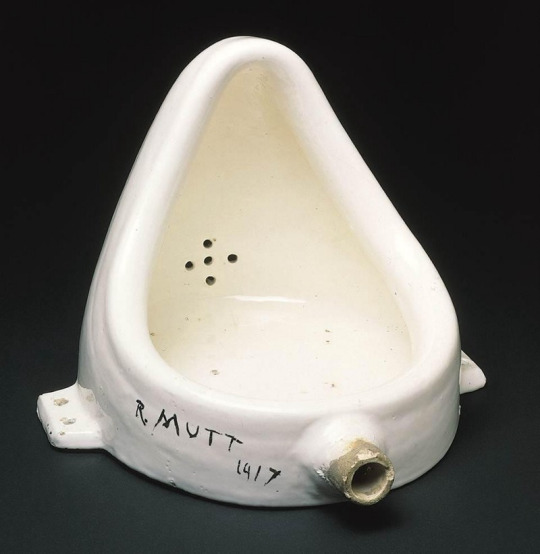
Fıskiye, Marcel Duchamp (1917)
Sanatın kavramsal yönünü vurgulamak için eserlerine güçlü isimler vermiştir. En önemli eserlerinden olan Fıskiye sanatçının bir pisuara attığı imzadan ibarettir. İmzayı ise kendi imzası olarak değil, dönemin meşhur çizgi film karakteri olan ‘R. MUTT’ adına atmıştır. Aynı zamanda bu kelime okunuş bakımından Almanca’da “fakirlik” anlamına gelmektedir. Ancak bu eser dönemin bazı sanat eleştirmenleri tarafından ahlak dışı ve hırsızlık olarak tanımlanır. Aslında önemli olan onun pisuarı seçmesidir. Günlük hayatta kullandığımız bir objeyi alır ve onun “kullanışlı” olan anlamını yeni bir başlık ve görünüşte bize geri verir. Yani bir bakıma “hiç”ten bir düşünce yaratır.

L.H.O.O.Q, Marcel Duchamp (1919)
Duchamp’ın bir başka eseri ise Mona Lisa reprodüksiyonu olan L.H.O.O.Q’dur. Bu eserinde Mona Lisa tablosunun bir kopyasına bıyık çizer ve altına L.H.O.O.Q imzasını atar. Bu kısaltmanın anlamı Fransızca “Kızın kalçaları ateşli.” cümlesinin baş harfleridir.
Duchamp sanatçının değerinin toplum tarafından çok abartıldığını düşünür. Sanat üretimini otuzlu yaşlarında bırakır ve hayatının geri kalanını satranç oynayarak geçirir. 81 yaşında vefat eder.
Kavramsal Sanat 60’lara kadar çeşitli eserlerde kendini gösterse de tanımı 60’larda yapılmıştır. Sol Lewitt “Kavramsal Sanat Üzerine Paragraflar” makalesini 1967’de yazmıştır. Sanatın en önemli yönünün fikir olduğunu söyler. Lewitt’e göre eser yapılmadan planlanır ve “Eğer ki fikir iyiyse, eser doğrudan iyidir.” tezini savunur. Onun için sanat sadece göze değil beyne de hitap eder. “Başarılı eser bakış açımızı değiştirendir.” der.
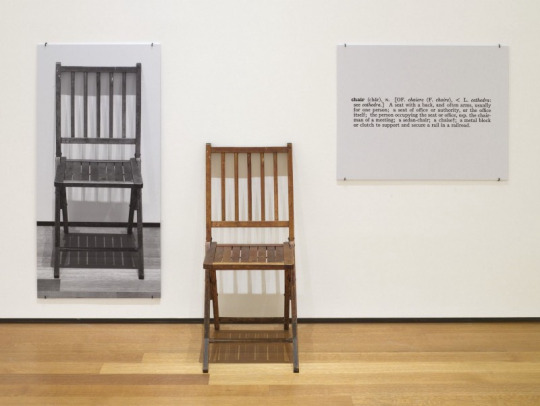
Bir ve Üç Sandalyeler, Joseph Kosuth (1965)
Kavramsal Sanatın bir diğer öncüsü ise Joseph Kosuth’tur. “Kavramsal Sanat, sanatın özünü sorgulayandır.” demiştir. Önemli eserlerinden biri olan Bir ve Üç Sandalyeler’de sandalyenin kendisini, fotoğrafını ve sandalyenin sözlük anlamını yan yana koymuştur. Onun için anlam çok önemlidir. Kosuth aynı zamanda ‘Sanat ve Dil’ grubunun üyesidir. Bu grup Kavramsal Sanatın ve sanatçıların dili olmayı amaçlamıştır. “Sanatın doğası nedir?” sorusu bu grup için büyük önem teşkil eder. 1967’de yazdığı ‘Felsefeden Sonra Sanat’ makalesinde “Duchamp’dan sonra bütün sanat eserleri kavramsaldır çünkü sanat sadece kavram olarak varolabilir.” demiştir.
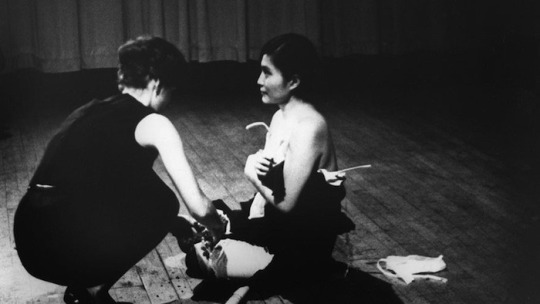
Parçayı Kesmek, Yoko Ono (1964)
Performans sanatçısı olan Yoko Ono ise Vietnam Savaşını eleştirmek için Parçayı Kesmek adlı eserini 64 senesinde sergilemiştir. Bu eserde izleyiciler teker teker gidip Ono çıplak kalana kadar kıyafetinden bir parça keser. Yoko Ono eserini performe ederken risk alarak insan şiddetine dikkat çekmek istiyordu. Yoko Ono Fluxus Hareketi üyesiydi. Bu hareket popüler kültüre yönelik harekete karşıydı. Kendilerini aynı zamanda Neo-dadaist olarak adlandırdılar. Halkın katılımı, Parçayı Kesmek’de olduğu gibi neo-dadaist için önemliydi. Halk ve sanatçı arasındaki sınırları yok ederek “Herkes sanatçı olabilir.” dediler.
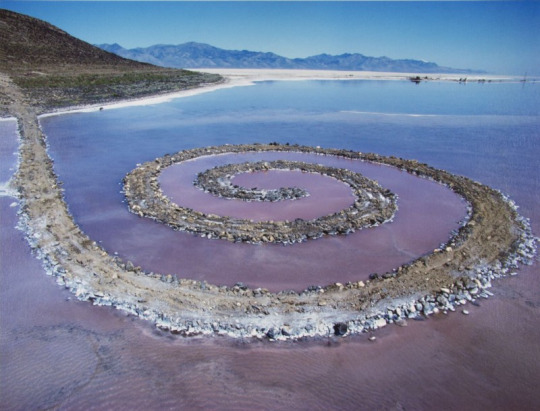
Spiral Dalgakıran, Robert Smithson (1970)
70’lerde ortaya çıkan Arazi Sanatı ve Performans Sanatı da Kavramsal Sanatın konularındandır. Arazi sanatçısı olan Robert Smithson Spiral Dalgakıran’ı yaparken doğanın gücünü göstermek istemişir. Toprak yığınından yapmış olduğu dev spiral dalgakıran yaklaşık bir yıl içerisinde yok olmuştur. Spiral şeklinde olmasının nedeni ise spiralin doğada en çok bulunan formlardan biri olmasıdır.
Kavramsal sanat ile birlikte artık sanat maddesizleşmişti yani eş zamanlı olarak gözlemlenemiyordu. Yukarıda bahsedilen iki örnek gibi sanat eserlerini artık video veya fotoğraflarla da gözlemlemek mümkündü. Çünkü artık önemli olan görsellik değil fikirdi. Bu konuyu ilk olarak 1968'de Lucy Lippard Sanatın Maddesizleşmesi makalesinde ele almıştır.

MoMA- Poll, Hans Haacke (1970)
Başka bir önemli sanatçı olan Hans Haacke ise sert mizaçlı biriydi. İşleri bütünüyle politikti. MoMA-Poll isimli eserinde izleyicilere “Vali Rockfeller’in Başkan Nixon’un Vietnam Politikasını kınamaması Kasım’da ona oy vermemeniz için bir neden midir?” sorusunu sorar ve cevaplarını kutluya atmalarını ister. Bir bakıma insanları bu fikir hakkında düşünmeye sevk etmek ister.
Kavramsal sanat için önemli olan fikir olduğuna göre onu seçen insan da bir o kadar önemlidir, bu ucu çok açık bir sanat konusu olduğu için günümüzde sanatçılar bu dalda sayısız eserler vermiştir. Kavramsal sanat ilk olarak 1969’da Harald Szeemann küratörlüğünde Tavırlar Forma Dönüşünce sergisi ile Avrupa sanat ortamında yerini almıştır. Szeemann’ın düzenlediği bir diğer sergi ise Documenta 5'tir. Tematik büyük sergiyi gerçekleştiren ilk küratördür. Eski Documenta sergileri büyük resimlere sahip iken, Documenta 5’ de performans sanatı ve deneysel filmler gibi kavramsal sanatın çoğu dalına yer verilmiştir. Günümüzde ise bienaller en önemli kavramsal sanat etkinlikleridir. Hemen hemen her dünya başkentinde gerçekleştirilen bu sergiler iki yılda bir olup ulusal ve uluslararası sayısız esere ev sahipliği yaparlar.
Diğer Kaynaklar
Norbert Lynton, Modern Sanatın Öyküsü, çev. Cevat Sapan — Sadi Öziş (İstanbul: Remzi Kitabevi, 2004), s. 123–134.
“Cut Piece (1964)”, http://onoverse.com/2013/02/cut-piece-1964/
Vasıf Kortun, “Bağımsız küratörlerin piri: Harald Szeemann”, Radikal, 2 Mart 2005, s.1.
#marcel duchamp#yoko ono#kavramsal sanat#sanat#robert smithson#hans haacke#joseph kosuth#sol lewitt#harald szeeman#fluxus#dadaizm#neodadaizm
0 notes
Photo

Concepts of Modern Art: From Fauvism to Postmodernism
The main concepts and development of art from about 1900 to the present are analyzed in authoritative essays by some of the most distinguished art historians and critics in Britain and the United States. With Edward Lucie-Smith on Pop Art, Suzi Gablik on Minimal Art, Norbert Lynton on Expressionism, and Sarah Whitfield on Fauvism, to name a few, these scholarly essays illuminate each particular artistic movement of the century, and together form an entire history of modern art. 123 illus.
View on Amazon
1 note
·
View note
Photo

Proyecto Vectorial 4/4 - Norbert Lynton (profesor de historia) dijo alguna vez: "De manera especial, los periodos de crisis parecen producir artistas que canalizan las ansiedades de sus épocas en sus trabajos" hoy, cito estas palabras por ser el día que es (12 de octubre) día de la raza. En mi país Venezuela, se celebra en este dia el descubrimiento de América, se conmemora el nacimiento de una nueva identidad cultural, que surge de la mezcla entre el pueblo español y los pueblos indígenas de América. Sin embargo hoy en dia enfrentamos un tema diferente; se ha hecho presente en nuestra nacionalidad un maltrato sin sentido que se deriva de la situación que está atravesando Venezuela actualmente, la Xenofobia que están viviendo los venezolanos en el exterior no tiene precedete, sobre todo en América latina, donde nos generalizan a todos, esto no debe seguir #NoMasXenofobia el inmigrante venezolano no se va de aquí por placer, y me parece necesario alzar la voz, porque a mí parecer el que calla otorga, y así sea en este pequeño espacio quieto compartir este mensaje, una crítica dirigida a todo aquel que piense que tiene derecho a maltratar y discriminar de cualquier forma, a un venezolano solo por su nacionalidad. #YoSoyVenezolano y me duele no solo por como me ha afectado la migración de personas en mi entorno, si no tambien por como me siento, cuando veo videos en las redes sobre el tema, el Venezolano no es menos que nadie, el Venezolano ha tenido que convertirse en una máquina para solventar problemas, y eso solo lo entiende el que ha tenido que sacrificar algo por los demas, por los que quiere y los que le importan, Venezuela está llena de talento, y no vamos a dejar que por unos pocos se nos señale a todos como la escoria de América Latina. Merecemos Respeto #YaBasta #NoMasXenofobia #Venezuela #Bird #Yellow #VectorIllistration @vector.mob https://www.instagram.com/p/Bo1XDk3Hp01/?utm_source=ig_tumblr_share&igshid=1eq3x45wwfe8j
0 notes
Photo

Norbert Lynton, 1900'den günümüze kadar modern sanatın öyküsünü anlatırken, okurun bu sanatla sıcak ve içten bir biçimde ilgilenmesini de amaçlıyor. Modern Sanatın Öyküsü'ne, 1980'li yılların sanatının ve sanat eleştirisinin gelişmesini içeren yeni bir bölüm eklenmiştir.
İçeriği daha da zenginleşen Modern Sanatın Öyküsü, çağımızın sanatıyla ilgilenen herkesin okuması gereken bir kitap olma özelliğinin sürdürmektedir.
0 notes
Text
20161120
Norbert Lynton suggested that publicly funded art education ‘came in with industrialization’ ;this focus on an industrial mode of production as the key explanatory factor, accompanied by the diminution of legislative agency within laser-faire political economy(自由放任经济政策), was introduced to debates on state-funded art education in the 1830s and had become received opinion by the end of the nineteenth century. In a keynote speech on the history of art education given at the Congress on Social Science in Huddersfield in 1883, Sir Rupert A. Ketter noted that ‘The Royal Academy of Arts was founded in 1765. The steam-engine was invented 20 years afterwards. The introduction of this wealth-producing power marks the point of time when the change in the social condition of the middle class commenced’ thus arousing public opinion in favour of alternatives to the academy, and leading to a situation where in 1883, ‘There is no considerable town in England now without a school of art’ It is an historical irony that this self-actualiazing, steam-driven, laissez-faire version of the political economy of art education was to affect the initial development of the publicly funded art school in England in the 1830s, as well as its relation to the Royal Academy of Arts. While Adam Smith could see an economic logic for new forms of pedagogy(教育学) emerging from quandary had an inhibiting effect on the utilitarian architects of the art school in nineteenth-century England, which this book address through a return to Bentham. 然而亚当斯密在当时功利主义学者建筑师在19世纪艺术学校的建筑上的窘状中看出了教育学中的经济学逻辑。
0 notes
Photo
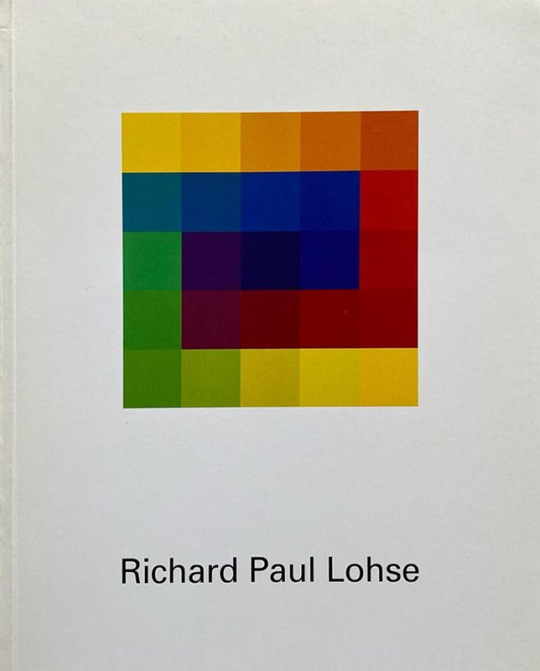
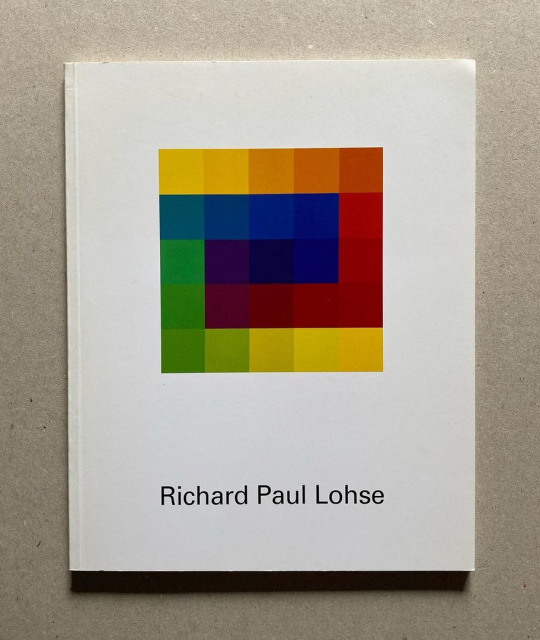

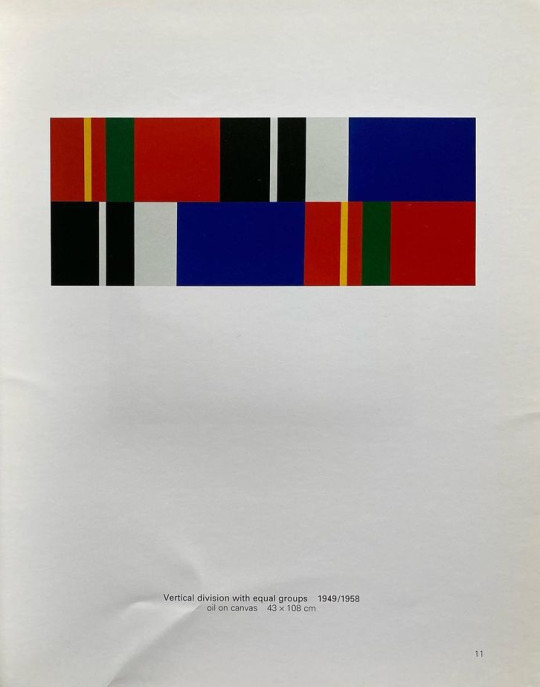





Richard Paul Lohse: 'Colour becomes Form', Text by Norbert Lynton, Annely Juda Fine Art, London, 1997 [Exhibitions: Annely Juda Fine Art, London, January 24 – March 1, 1997; Kettle's Yard, Cambridge, March 8 – April 27, 1997] [Art Books & Ephemera]
#graphic design#art#geometry#pattern#exhibition#catalogue#catalog#richard paul lohse#norbert lynton#annely juda fine art#kettle's yard#1990s
52 notes
·
View notes